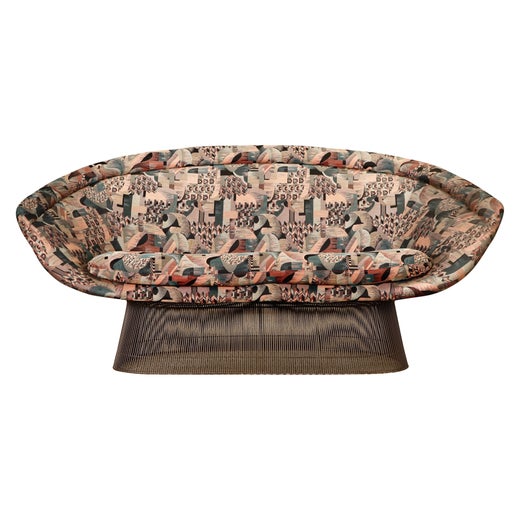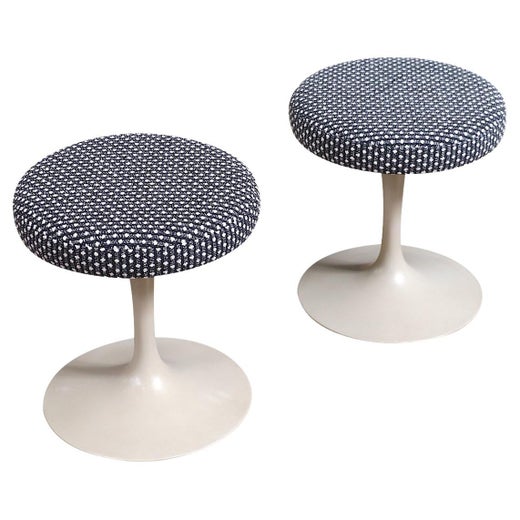Warren Platner Knoll Dining Table Walnut Top
About the Item
- Creator:Warren Platner (Designer),Florence Knoll (Manufacturer)
- Design:Platner Dining TablePlatner Series
- Dimensions:Height: 28.5 in (72.39 cm)Diameter: 54 in (137.16 cm)
- Style:Mid-Century Modern (Of the Period)
- Materials and Techniques:
- Period:
- Date of Manufacture:1970s
- Condition:Wear consistent with age and use. Minor fading. No breaks or damage to the base. 48" Wood top in very good condition, 54" top has a light glass ring but easy to restore.
- Seller Location:Chicago, IL
- Reference Number:Seller: MLH111stDibs: LU923317500311
Warren Platner
Though vintage Warren Platner chairs, sofas and interiors are icons of mid-century modernism, the architect and furniture designer took his stylistic inspiration from as far back as 18th-century France, once saying about his seminal collection for Knoll that his design intent was to evoke “the kind of decorative, gentle, graceful kind of design that appeared in period style like Louis XV.”
Indeed, the marriage of modern sensibility and classical grace is a marker of Platner’s style across furnishings and interiors — both genres in which he left an enduring legacy.
Born in 1919 in Baltimore, Maryland, Platner studied architecture at Cornell before cutting his teeth working for design icons like Eero Saarinen and Kevin Roche, eventually serving as head of interior design in the latter’s office. In 1965, Platner opened his own office, in Greenwich, Connecticut, where he continued to hone his particular brand of graceful modernism.
Knoll released the Platner Collection of seating and tables in 1966. (Originally designed in 1962, the suite took nearly four years of development to bring to life.)
The decorative bent-metal-and-glass pieces — an armchair, a dining table and more — make certain nods to the trademarks of his former employers, but also to the shapes of historic European furniture. The sculptural elegance of his line recalls Saarinen’s iconic Tulip collection, which includes armchairs and dining tables, while his materiality aligns with Roche’s cutting-edge use of glass and metal for the headquarters of the Ford Foundation in New York.
Many of Platner’s Knoll pieces would go on to find homes in a certain fabled locale: the Windows on the World restaurant at the original World Trade Center, whose interiors Platner was tapped to outfit in the mid-1970s. Upon the opening of the restaurant in 1976, New York Times architecture critic Paul Goldberger dubbed its style “sensuous modernism” — an apt tagline for Platner’s oeuvre as a whole.
Platner died in 2006 at the age of 86. His furniture is still produced by Knoll, and original examples — along with idiosyncratic custom works he created for interior design clients — are coveted by collectors today.
Find vintage Warren Platner furniture on 1stDibs.
Florence Knoll
Architect, furniture designer, interior designer, entrepreneur — Florence Knoll had a subtle but profound influence on the course of mid-century American modernism. Dedicated to functionality and organization, and never flamboyant, Knoll shaped the ethos of the postwar business world with her skillfully realized office plans and polished, efficient designs for sofas, credenzas, desks and other furnishings.
Knoll had perhaps the most thorough design education of any of her peers. Florence Schust was orphaned at age 12, and her guardian sent her to Kingswood, a girl’s boarding school that is part of the Cranbrook Educational Community in suburban Detroit. Her interest in design brought her to the attention of Eliel Saarinen, the Finnish architect and head of the Cranbrook Academy of Art.
Saarinen and his wife took the talented child under their wing, and she became close to their son, the future architect Eero Saarinen. While a student at the academy, Florence befriended artist-designer Harry Bertoia and Charles and Ray Eames. Later, she studied under three of the Bauhaus masters who emigrated to the United States. She worked as an apprentice in the Boston architectural offices of Walter Gropius and Marcel Breuer; Ludwig Mies van der Rohe taught her at the Illinois Institute of Technology.
In 1941, she met Hans Knoll, whose eponymous furniture company was just getting off the ground. They married in 1946, and her design sense and his business skills soon made Knoll Inc. a leading firm in its field. Florence signed up the younger Saarinen as a designer, and would develop pieces by Bertoia, Mies and the artist Isamu Noguchi.
Florence Knoll's main work came as head of the Knoll Planning Group, designing custom office interiors for clients such as IBM and CBS. The furniture she created for these spaces reflects her Bauhaus training: the pieces are pure functional design, exactingly built; their only ornament from the materials, such as wood and marble. Her innovations — the oval conference table, for example, conceived as a way to ensure clear sightlines among all seated at a meeting — were always in the service of practicality.
Since her retirement in 1965, Knoll received the National Medal of Arts, among other awards; in 2004 the Philadelphia Museum of Art mounted the exhibition “Florence Knoll: Defining Modern” — well deserved accolades for a strong, successful design and business pioneer. As demonstrated on these pages, the simplicity of Knoll’s furniture is her work’s great virtue: they fit into any interior design scheme.
Find vintage Florence Knoll sofas, benches, armchairs and other furniture on 1stDibs.
You May Also Like
Vintage 1960s American Mid-Century Modern Dining Room Tables
Marble, Steel
Early 2000s American Mid-Century Modern Tables
Nickel
Vintage 1960s American Space Age Center Tables
Steel
20th Century Unknown Mid-Century Modern Dining Room Tables
Steel
Vintage 1960s American Mid-Century Modern Dining Room Tables
Marble, Metal
Vintage 1960s German Mid-Century Modern Dining Room Tables
Chrome
Vintage 1960s American Modern Dining Room Tables
Steel
Mid-20th Century American Mid-Century Modern Dining Room Tables
Bronze
Vintage 1960s Dining Room Tables
Marble, Steel
2010s American Mid-Century Modern Dining Room Tables
Chrome

